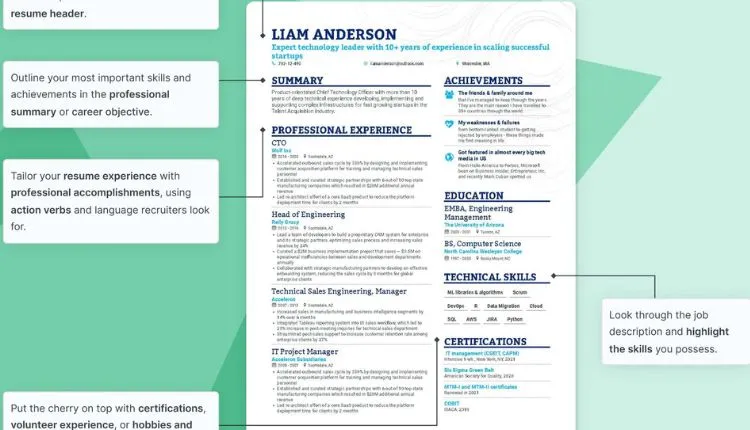Writing a resume is an important step in any job search. It is the first impression a potential employer will have of you and is the most important document in the job search process. The resume is a snapshot of who you are and what you can bring to the organization. Therefore, it is important to make sure that your resume is well-written and highlights your skills, experience, and qualifications. This guide will provide you with the tools and tips necessary to create an effective resume that will help you stand out from the competition.
What is a resume?
A resume is a document that outlines your professional experience, skills, and education. It is an essential tool for job seekers, as it serves as a representation of who you are and what you can bring to a potential employer.
At its core, a resume is a marketing document that shows potential employers why they should hire you. It should include information about your professional experience, skills, and education. It should also include any awards or honors you have received. Furthermore, it should be tailored to the specific job you are applying for.
When writing your resume, include keywords that employers are looking for. Pay attention to the job description and make sure to include any relevant experience or skills that are listed. Additionally, don’t forget to highlight any transferable skills you have, such as communication or problem-solving skills.
When it comes to formatting your resume, it’s important to keep it clean and minimalistic. Avoid using too many fonts or colors, as it can be distracting to employers. Additionally, make sure to keep the format consistent throughout your resume.
Finally, proofread your resume and make sure that there are no spelling or grammar mistakes. Employers will be looking for attention to detail and a well-crafted resume.
Overall, a resume is a crucial tool for job seekers. It should be tailored to the job you are applying for and should highlight your professional experience, skills, and education. By following these tips, you can ensure that your resume stands out from the competition.
Understanding Your Strengths and Weaknesses
We all have strengths and weaknesses, but knowing and understanding them is essential to success. Recognizing your strengths and weaknesses can help you to hone your skills and find new, creative ways to use them. It can also help you to identify areas of growth and improvement, allowing you to make the most out of your strengths and work on improving your weaknesses.
Analyzing your skills is a great way to start understanding your strengths and weaknesses. Take a few moments to think about the things that you are really good at. Make a list of the skills and qualities that you possess that could be beneficial to your job or career. Consider your strengths in communication, problem solving, and technical knowledge, as well as any other skills that you feel you excel at. Once you have identified your strengths, think about how you can use them to your advantage.
After you have identified your strengths, it’s time to take a look at your weaknesses. Again, make a list of the areas where you feel you could use improvement. Consider your weaknesses in communication, problem solving, and technical knowledge, as well as any other areas where you feel you could use some practice. Once you have identified your weaknesses, think about how you can work to improve them.
Formatting Your Resume
If you’ve ever looked for a job, you know that a professional, well-formatted resume can be the difference between getting an interview and being passed over. In today’s competitive job market, it’s more important than ever to make sure your resume stands out. That’s why understanding how to properly format your resume is so critical.
Choosing the Right Format
The first step in formatting your resume is to choose the right format. Should you use a chronological format, a functional format, or a combination of the two? Chronological resumes are best for job seekers who have a steady work history with no long gaps in employment. Functional resumes, on the other hand, are better for those who have some gaps in their employment or those who are transitioning to a new career. Finally, the combination format combines elements of the chronological and functional formats, so it’s best for job seekers who have a mix of qualifications.
Layout and Design
Once you’ve chosen the right format, it’s time to think about layout and design. Your resume should be visually appealing, so choose a font and color scheme that’s easy to read. Make sure your font is professional and consistent throughout the document. Also, make sure to keep your headings and subheadings bold and clear.
Sections and Content
Finally, make sure that your resume is organized into appropriate sections with clear headings. Your resume should include sections like Summary of Qualifications, Work Experience, Education and Skills. Each section should have relevant, up-to-date information that showcases your qualifications. Make sure to tailor each resume to the job you’re applying for.
Formatting your resume is an important part of the job search process. With the right format, layout, design and sections, you’ll have a professional, polished resume that will help you land the job you want.
Writing Your Resume
Writing a resume can be an intimidating task, but with the right approach, it doesn’t have to be. Whether you’re starting from scratch or refreshing an existing resume, there are a few components that can help make your resume stand out from the crowd.
Crafting an Effective Summary
Your resume should begin with a strong summary that outlines your professional experience, accomplishments, and key skills. This summary should be concise and capture the attention of hiring managers. Think about the key points you want to emphasize in your resume and use those to craft a summary that will grab recruiters’ attention.
Describing Your Education and Experience
Your next step should be to list your education and work experience. Be sure to include all relevant information, such as the institution you graduated from, any internships or jobs you’ve held, and any certifications you’ve earned. Also, be sure to list any awards or honors you’ve received.
Including Relevant Skills
Finally, be sure to include any relevant skills you possess. Hiring managers look for candidates who have the skills they need to succeed in the position they’re filling. List any technical or other skills that you have that match the job description. This will ensure that hiring managers see you as a strong candidate.
Overall, writing a resume can be a daunting task, but with a few simple steps, you can create a resume that will grab recruiters’ attention and help you land the job you’ve been dreaming of. With the right approach, you can craft a resume that will get you noticed.
Finalizing Your Resume
When it comes to applying for jobs, a well-crafted resume is essential. It’s the first thing potential employers will see and should make a good impression. That’s why it’s important to take the time to make sure your resume is perfect before you submit it. Here are some tips for polishing and proofreading your resume to make sure it’s ready to go.
Polishing and Proofreading
Before you submit your resume, take the time to go through and make sure it’s in tip-top shape. Start by ensuring that there are no typos or grammar errors. It’s easy to miss mistakes when you’ve been staring at the same document for hours on end, so consider having a friend or family member look over your resume as well.
It’s also important to make sure your resume is well organized and easy to read. Use clear formatting to help separate sections and make sure that the most important information is easy to find. Avoid long paragraphs and try to use bullet points or lists to break up the text.
Final Tips and Tricks
Before submitting your resume, You need to know about How To Make A Resume and consider what other materials you can include to help yourself stand out. For example, if you have any professional certifications or awards, consider adding them to your resume. You can also include a link to any websites or profiles you’ve created, such as a portfolio site or social media account.
Finally, make sure you double check that your contact information is correct. You don’t want to miss out on a great opportunity simply because a potential employer couldn’t reach you.
Polishing and proofreading your resume is the last step before submitting it for a job application. Taking the time to make sure your resume is in the best shape possible can help you make a great impression and increase your chances of getting an interview. With the right preparation and attention to detail, you’ll be well on your way to getting the job of your dreams.
Conclusion:
Writing a resume is an important part of the job search process. Having a well-crafted resume can help you stand out from the competition and make a great first impression on potential employers. By following the steps outlined above, you can create a resume that highlights your skills and qualifications, communicates your value, and encourages the reader to contact you for an interview. Good luck with your job search.












